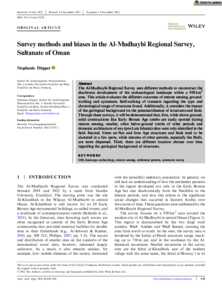Document
Survey methods and biases in the Al-Mudhaybi regional survey, Sultanate of Oman.
Identifier
DOI: 10.1111/aae.12224
Source
Arabian Archaeology and Epigraphy. v. 34, S1, p. S39-S50
Country
United States.
City
New Jersey
Publisher
John Wiley and Sons Inc.
Gregorian
2023-11-01
Language
English
English abstract
The Al-Mudhaybi Regional Survey uses different methods to reconstruct the diachronic development of the archaeological landscape within a 930 km2 area. This article evaluates the different outcomes of remote sensing, ground-truthing and systematic field-walking of transects regarding the type and chronological range of structures found. Additionally, it considers the impact of the geological background on the presence/absence of structures and finds. Through these surveys, it will be demonstrated that, first, while above-ground, solid constructions like Early Bronze Age tombs are easily spotted during remote sensing, smaller, often below-ground tombs of other periods and domestic architecture of any (pre-Late Islamic) date were only identified in the field. Second, Umm an-Nar and Iron Age structures and finds tend to be clustered in a few spots, while remains of other periods, especially the Hafit, are more dispersed. Third, there are different location choices over time regarding the geological background of structures.
ISSN
0905-7196
Category
Journal articles

